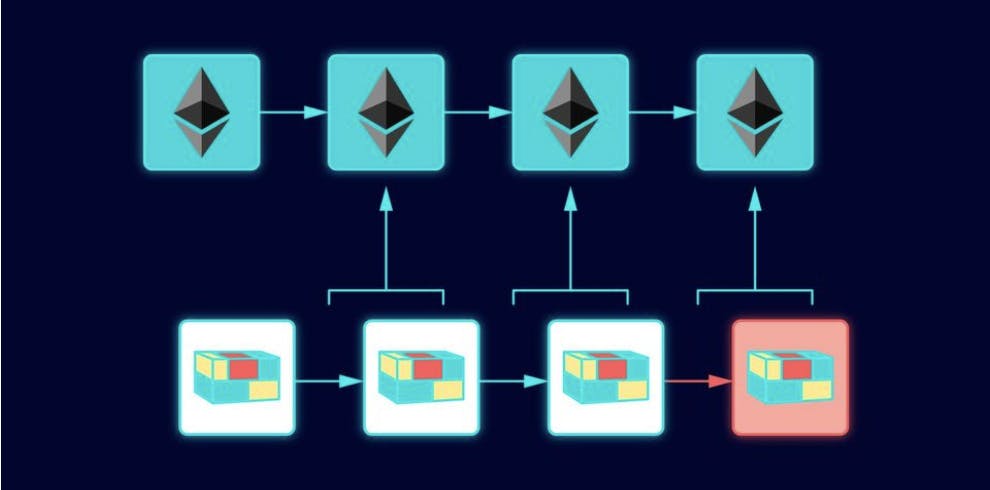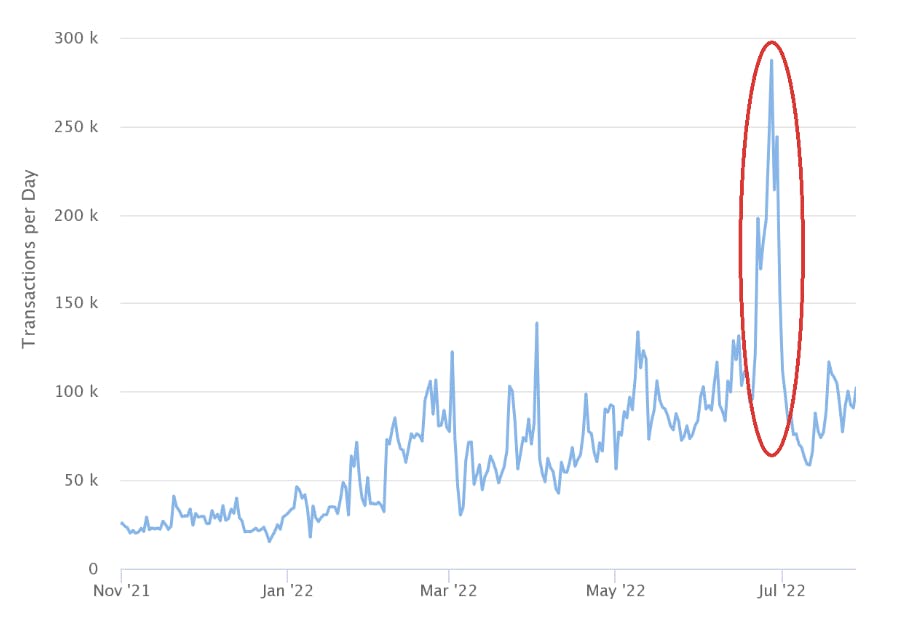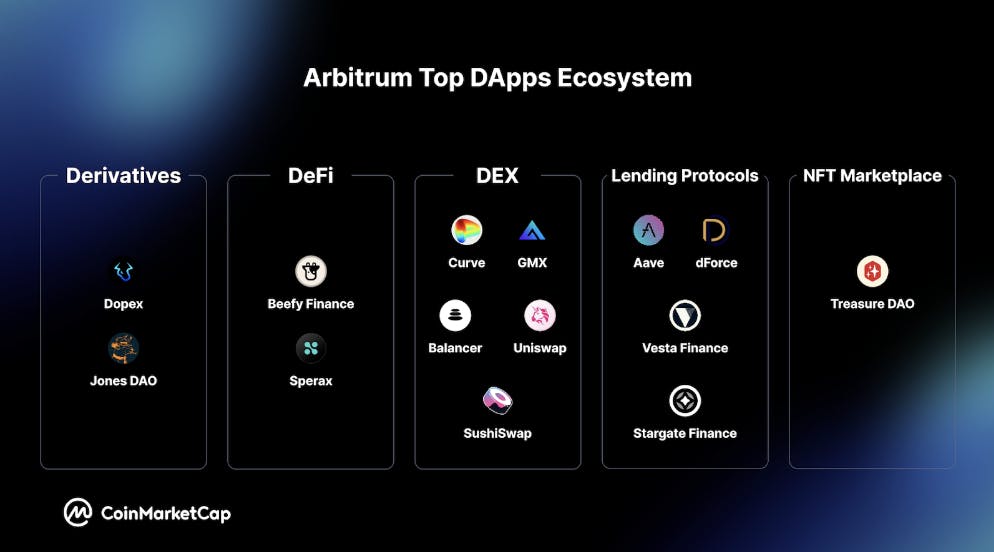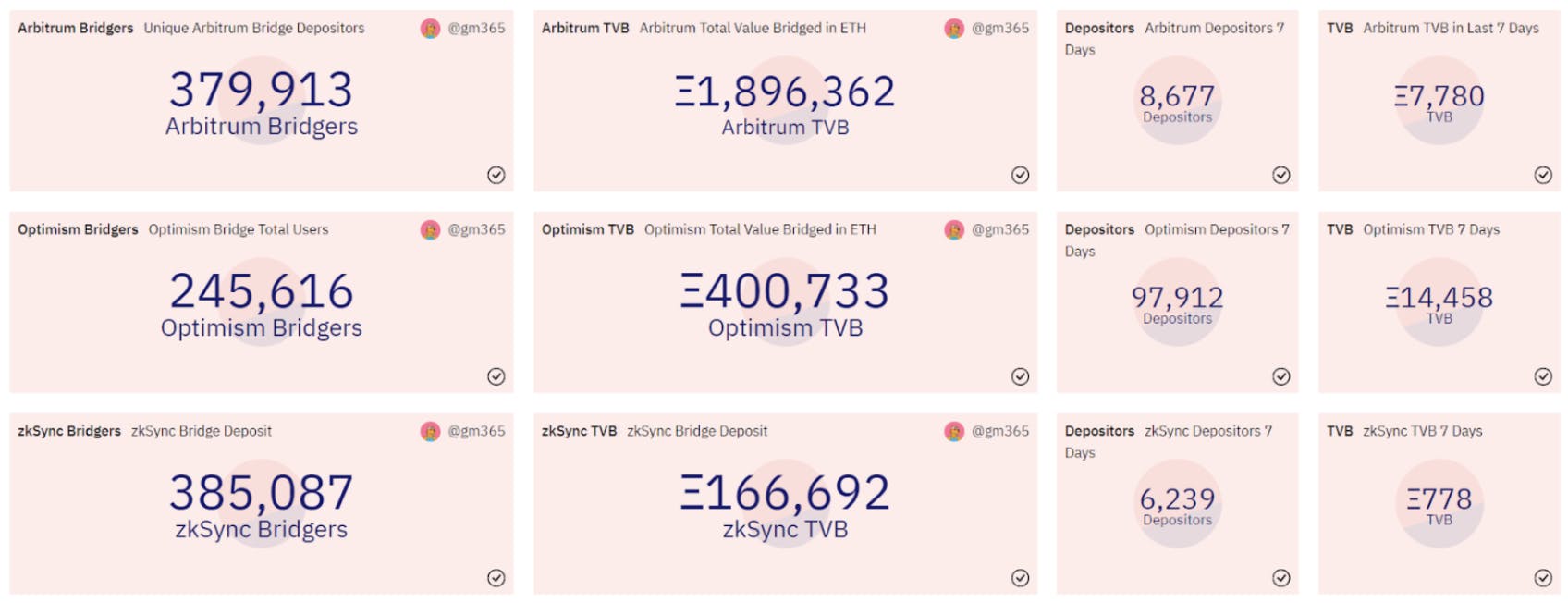Arbitrum: Scaling Ethereum
2022-10-04 • Aidan Chen
GM everyone, welcome back to the Blockchain at Georgia Tech newsletter! We are going to be diving into the Ethereum layer 2 scaling solution, Arbitrum. Since July 1st, Arbitrum has seen total value-locked (TVL) gains of over 35%, despite ETH numbers remaining flat during that same period. In the face of all the hype surrounding the Ethereum Merge, Arbitrum revealed itself as a winner through its outperformance within an otherwise stagnant crypto market. Today, we’re going to be discussing some of the basics of the layer 2 technology that powers Arbitrum, allowing transactions to take place at a fraction of the time and cost compared to most layer 1s. We’ll cover the history of the protocol, and break down some of the numbers to understand why and how the chain has managed to gain so much traction recently. Finally, we’ll look towards Arbitrum’s future, highlighting some of the significant events on their roadmap. Throughout this piece, our use of “Arbitrum” refers to the Arbitrum One optimistic rollup, unless otherwise specified.
What is a Layer 2?
Before we get started with investigating Arbitrum specifically, it’s important to understand what exactly layer 2 means. According to an article from Binance Academy, a layer 2 refers to “a secondary framework or protocol that is built on top of an existing blockchain system.” In Arbitrum’s case, the existing blockchain is Ethereum. On the Ethereum network, validators are incentivized to approve transactions by being paid a fee known as gas. During periods of high activity, the network can get congested as participants bid the gas price higher in order to see their transactions processed. Many layer 2s are designed to alleviate this network congestion by processing bundles of transactions (hence the term “rollups”) off-chain, then submitting them as a single transaction on the mainnet. This allows for much higher throughput while maintaining the decentralization and security of the network via the underlying blockchain.

How can they ensure that the “rollup” of transactions that’s submitted to the Ethereum network is valid? This is where distinctions between scaling solutions begin to form. The layer 2 category can be broken down further into zero-knowledge (ZK) rollups and optimistic rollups. ZK rollups prove the validity of transaction bundles via a cryptographic “zero-knowledge proof”. As the name suggests, this method can verify transactions without needing to examine underlying data, making block validation very quick. Some examples of ZK rollups include Loopring and ZKSync.
Projects like Optimism and Arbitrum fall into the category of optimistic rollups. Rather than prove validity, optimistic rollups assume that transactions are valid by default, and will only call for proof when a transaction is disputed as fraudulent. Any user can dispute a transaction as fraudulent during a set period of time, but frivolous disputes can be costly since each one requires the challenger to post a bond, which they are subject to loss if wrong. As a result of this system, transactions may take additional time to settle to the mainnet, which will affect users bridging their tokens from rollup back to Ethereum. Arbitrum and Optimism differ mostly in their fraud-proof systems. Optimism utilizes a non-interactive fraud-proof model, where a single party can prove the incorrectness of a transaction via one large on-chain execution. Arbitrum, on the other hand, uses an interactive model, where two or more parties may go back and forth until they find the specific segment of a transaction they disagree on and then execute that segment alone to verify its validity. While the distinctions between these two models can get quite technical, the end result is that Arbitrum is able to support a larger quantity of transactions at a cheaper price. Arbitrum also uses its own Arbitrum Virtual Machine (AVM) capable of supporting all EVM compatible programming languages, while Optimism can only compile Solidity.
History of Arbitrum
Arbitrum was launched by Offchains Lab, an impressive team of developers out of Princeton University. The beta version of Arbitrum One, their flagship optimistic rollup product, was released to developers on mainnet Ethereum on May 28, 2021. The company made waves after a Series B raise of $120 million at a $1.2 billion valuation, and shortly after completed public launch of Arbitrum One in August 2021. The network was released with existing centralized permissions and throttled speeds, with plans to move towards full decentralization and processing power in future stages. Initially, they saw massive growth, reaching $2.6 billion in TVL by the peak of crypto markets during November of the same year. Despite a moderate downturn in DeFi as a whole, the Arbitrum ecosystem maintained activity with various protocol launches and integrations throughout the next few months. In April 2022, the team announced plans to roll out Arbitrum Odyssey, a program designed to increase ecosystem activity by incentivizing use of popular projects with NFT airdrops. It was rumored that through participating in Odyssey, users would set themselves up to receive a future $ARBI token airdrop. When the eight week program started in late June, it was an overwhelming success, causing activity on the chain to reach all-time highs.

However, throttled speeds led to network congestion and gas prices at one point even having surmounted those on Ethereum. The team was forced to put the program on pause within a week in hopes to resume once the chain had the capacity for more activity. Exactly one year after its initial launch on August 31, Arbitrum completed a major milestone via its migration to Arbitrum Nitro, the final step in a series of upgrades designed to unlock the full power of the chain’s innovative infrastructure. The upgrade optimized the processing capability of Arbitrum by cutting out a step in the compilation of code, except when that step is specifically called to execute in the presence of a dispute resolution. Since then, users have enjoyed lightning fast transaction speeds at gas costs upwards of 25 times cheaper than those on mainnet Ethereum.
Ecosystem Growth
Aside from some of the performance factors that have led Arbitrum to capture a large user base, investors are also flocking to the layer 2 for its vibrant DeFi ecosystem. The project carried out a strategy designed to onboard a large variety of DeFi protocols, with over 400 apps whitelisted prior to public launch. Due to its EVM compatibility, familiar DeFi giants like Uniswap and Curve Finance deployed on Arbitrum and were available to users within the first few weeks.

Arbitrum was also an attractive pick for smaller protocols looking to build on a layer 2 platform, since they were one of the earliest to release their testnet for developers. Dopex, a decentralized protocol offering a variety of options trading products, wanted to launch their platform on a layer 2 to alleviate transaction costs. The project first announced that they would be launching on Optimism, but were later able to get whitelisted on Arbitrum and released their project there instead. Within a year of launch, Dopex has become one of the largest options platforms across all of DeFi and offers options strategies and vaults for popular tokens including ETH, BTC, and CRV. Despite the recent market downturn, the team continues to build. The recently launched Atlantic Straddle Vaults have been very successful due to outsized returns over the first several epochs. In addition, their roadmap has several new products to be released which will help retain users and bring value to the Arbitrum ecosystem.
The success of projects like Dopex is not unique. Take, for example, the performance of decentralized perpetual exchange GMX, which is up a staggering 109% on the GMX/ETH pair over the last 90 days. GMX launched on Arbitrum initially in August 2021 and has quickly become the darling token of the ecosystem. GMX is part of a recent wave of protocols that distributes a portion of protocol revenues back to its token holders. Owners of the token GMX and GLP, an associated protocol token that also pays out yield, have taken home a cumulative $20 million in swap and trading fees over the past two months alone. Despite troubling market conditions across DeFi markets, GMX TVL and trading volume sit at or near all-time highs. The stories of GMX and Dopex demonstrate a noticeable trend among many projects in the Arbitrum ecosystem. A significant amount of native protocols have outperformed compared to Ethereum in the past 90 days, as can be seen below. Not only that, but they continue to focus on development and shipping new features to attract organic growth in the absence of an Abitrum-wide incentives program.

Outside of DeFi, the NFT space remains a great indicator of ecosystem activity. An interesting Arbitrum project is Trove, the NFT marketplace launched by TreasureDAO. The platform was created as a space for users to buy and list NFTs within the TreasureDAO ecosystem, which you can learn more about in one of our past newsletters. Trove has also partnered with additional Arbitrum-native projects, like GMX Blueberry Club and The Garden of Arbitrum. The Arbitrum NFT space could bring in significant activity going forward, especially if gas prices on mainnet Ethereum begin to rise and force traders to look for cheaper alternatives. OpenSea, which remains the largest NFT marketplace across any platform, recently announced integration with the chain. It seems that Arbitrum is well-positioned to take advantage of a potential rise in NFT activity if retail capital returns to the space.
The strength of the Arbitrum ecosystem can be better put into perspective when compared with other layer 2 protocols. The graphic below details the amount of users bridging and the total value bridged (TVB), between Arbitrum and rival layer 2s Optimism and zkSYnc. While all 3 protocols have comparable figures for total unique bridgers, the TVB of Arbitrum all-time dwarfs that of any other layer 2. The chain has managed to attract a large inflow of capital per bridger, indicating that Arbitrum users feel comfortable depositing their money within the ecosystem. TVL tells a similar story, with Arbitrum leading the market at 50.8% of all layer 2 market share. Optimism follows in second place with 30.8%, reflecting about a $1 billion total difference in locked capital between the chains. Considering that Arbitrum has yet to release a native token, which accounts for a sizable percentage of capital on most other layer 2s, these figures are quite impressive.

Risks and Concerns
As with any blockchain project, the threat of smart contract risk is ever present and should not be understated. An additional concern specific to layer 2 platforms is bridging. The bridge from mainnet Ethereum to Arbitrum represents one of the most vulnerable targets for potential hackers, since virtually all capital must move through this point to reach the desired chain. Earlier this year, hackers stole more than $600 million in funds from the bridge of Ethereum sidechain Ronin. Fortunately, Arbitrum’s fraud-proof system, which leads to withdrawal lockups of 7 days, has served as a deterrent for bridge-related exploits thus far. It should be noted that several third-party protocols allow users to bridge funds back and forth without delay by implementing liquidity provider mechanisms on both chains. While using these protocols may help avoid the long wait, they present far more risk to the investor and should be approached with caution. Many DeFi participants may also worry about how upcoming updates to Ethereum will affect Arbitrum and other layer 2s. Functionally, upgrades like the Ethereum Merge or future performance improvements will make no changes to Arbitrum. If anything, as Ethereum continues to scale, scaling solutions will benefit from faster transactions and cheaper fees. The founders of Arbitrum believe there will be a meaningful market for both layer 2 products and mainnet Ethereum going forward.
The Future of Arbitrum
Odyssey
Arbitrum and many of its ecosystem projects have found themselves in the spotlight of crypto markets recently. As with most narratives, it can be hard to differentiate between a temporary capital rotation or a more meaningful push in adoption. As macroeconomic conditions begin to tighten on the entire space, outlook may start to appear more blurry. However, there are several promising catalysts for Arbitrum that may bode well for activity in the future. While no date has been announced for the resumption of the Arbitrum Odyssey program, this is the next major milestone investors are monitoring. When a formal statement was released putting the program on pause back in June, the team revealed that it would resume upon completion of migration to Arbitrum Nitro. With the Nitro upgrade nearly a month behind us, Arbitrum Odyssey should resume soon.
Token
Further down the line, the possibility of an $ARBI token airdrop is in the back of many minds. In a report from Coindesk, one of the founders specified that the central controls designed to establish the chain will be phased out in stages, with the goal of full decentralization. With this in mind, there is room to reason that Arbitrum will be governed by a DAO. In this scenario, governance distribution may follow in the steps of other decentralized protocols through the airdrop of a native token. Offchain Labs has yet to announce any immediate plans for a token launch, but many speculate that it will happen at some point in the future.
Arbitrum Nova
Up to this point, we’ve referred exclusively to Arbitrum One, the optimistic rollup product offered by Offchain Labs. The company has also recently announced the launch of another product, Arbitrum Nova, which runs on a technology coined “AnyTrust”. Compared to Arbitrum One, Nova’s AnyTrust is designed to lower transaction costs by removing the need to post data to mainnet, which has high gas consumption. It does so by relying on an external data availability committee to store and serve data on demand. Arbitrum Nova is targeted towards a more institutional market like game developers or social projects requiring high transaction throughput. Social media giant Reddit recently demonstrated the efficacy of the network by announcing plans to migrate their community points system to Nova. This move represents the onboarding of hundreds of millions of new users to blockchain technology, an impressive feat in and of itself. As Nova continues to gain traction, it may act as a vehicle to introduce the masses to crypto, the side effects of which will only benefit the entire Arbitrum ecosystem.
Competition with ZK Rollups
We touched briefly earlier on ZK rollups. Compared to optimistic rollups like Arbitrum, many believe ZK-proofs to be the superior technology. They have the power to confirm transactions far quicker, require a lockup period of a few minutes vs. several days, and can be configured to protect the privacy of transactions more easily. Despite these reasons, why have optimistic rollups seen far more adoption? One answer may simply be time. The development of optimistic rollup scaling solutions is at least a few years ahead of ZK solutions, most of which will require further polishing and testing before mass adoption begins. In a piece published in early 2021, Vitalik Buterin stated: “In general, my own view is that in the short term, optimistic rollups are likely to win out for general-purpose EVM computation and ZK rollups are likely to win out for simple payments, exchange and other application-specific use cases, but in the medium to long term ZK rollups will win out in all use cases as ZK-SNARK technology improves.” While their ultimate technological capabilities may surpass optimistic rollups, the verdict is still out as to whether or not ZK solutions will attract the same momentum as their earlier counterparts. Will users value the improved performance features enough to switch completely and kill optimistic rollups? Or, perhaps the established community and first-mover advantage of a network like Arbitrum will remain strong enough to retain its user base. Only time will tell.
Additional Resources
Fraud-proof resolution:
https://medium.com/@cpbuckland88/fraud-proofs-and-virtual-machines-2826a3412099
Distinction between ZK and Optimistic Rollups:
https://blog.matter-labs.io/optimistic-vs-zk-rollup-deep-dive-ea141e71e075
Arbitrum Nitro:
https://developer.offchainlabs.com/why-nitro
Arbitrum Nova:
Blockchain @ Georgia Tech Socials
If you enjoyed this deep dive stay up to date with Blockchain at Georgia Tech’s upcoming events and posts by following us on Twitter and LinkedIn!
Sources
https://www.coindesk.com/tech/2021/08/31/inside-arbitrums-staggered-mainnet-launch/
https://thedefiant.io/three-arrows-liquidated
https://academy.binance.com/en/glossary/layer-2
https://blog.saddle.finance/everything-you-need-to-know-about-optimistic-rollup/
https://tokeninsight.medium.com/optimism-vs-arbitrum-a-complete-comparison-f504f727e4df
https://cryptobriefing.com/defi-project-spotlight-dopex-options-built-simplicity/
https://cryptobriefing.com/which-ethereum-layer-2-will-be-next-airdrop-token/
https://vitalik.ca/general/2021/01/05/rollup.html
https://www.reddit.com/r/CryptoCurrency/comments/wk75p2/pack_your_moons_were_moving_to_mainnet/
https://twitter.com/arbitrum/status/1546560661282586626?lang=en
https://twitter.com/arbitrum/status/1542159105946787840?s=20&t=WaEmWu03ijB2hOUtCeIIUg
https://twitter.com/opensea/status/1572250900198203392?s=20&t=6PlFbxyVdC0qjM4RyaOZBg
Data
https://sigdev.thetie.io/dashboard